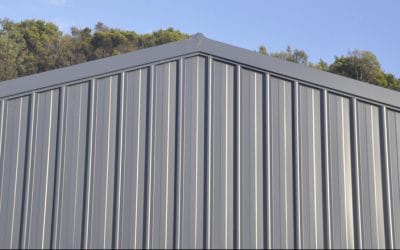Best Way to Heat a Shed | Discover Your Options
Today we are going to explore the best way to heat a shed in winter, highlighting the best options available on the market and their pros and cons. Discover what the best heater for your shed is and pay attention to the important safety tips and advice outlined in this blog.
Why heat your shed?
Heating your shed can transform it from a simple storage space to a year-round functional room. Here are a few reasons why you might consider heating your shed:
Extended usability: As the colder months roll in, unheated sheds can become uncomfortable or even unusable due to low temperatures. By adding a heating system, you ensure that your shed is cosy and welcoming all year round.
Protection of stored items: Many items, such as electronics, certain types of machinery, and some materials, are sensitive to cold temperatures and can get damaged if left in an unheated shed during winter.
Comfort and Enjoyment: Lastly, there’s no denying the pure comfort and enjoyment that a heated shed provides. Whether you’re working on a project or simply retreating for some alone time, a warm shed can be a haven during those chilly months.
Assessing your needs
Before you decide on a heating method for your shed, several factors come into play that can influence your choice. These considerations ensure that you choose the most effective and efficient heating system for your specific needs.
Shed size
The size of your shed is a key determinant in the type of heating you’ll need. Larger sheds may require more powerful heating systems or even multiple units to ensure the space is adequately heated. Conversely, a small, well-insulated shed might need just a small heater to keep it comfortable.
Insulation
The insulation of your shed is crucial for maintaining a steady temperature. A well-insulated shed retains heat more efficiently, reducing the energy required to keep it warm. If your shed isn’t insulated, you might want to consider adding insulation before investing in a heating system, as this can greatly enhance the efficiency of your heater. For more details, check out our blog on How to Insulate Your Shed.
Ventilation
Proper ventilation is important for any space where a heater is in use. Ventilation helps control humidity levels and prevents the build-up of dangerous gases, especially if you are using a gas or propane heater. Your shed’s current ventilation will affect the type of heating system you should install. For more information, check out our Guide on Shed Ventilation.
Intended use
How you plan to use your shed also impacts your heating choice. If you’re using the shed as a workshop, you might need a more robust heating system that can withstand the colder months. If it’s a storage area for temperature-sensitive items, a steady, moderate heating solution might be more suitable.
Local climate
The climate in your area is another factor to consider. If you live in an area with mild winters, a simple, low-cost heater may suffice. However, if your area experiences harsh, cold winters, you’ll need a more powerful heating system.
Heating options
When it comes to heating your shed, you’ll find that there’s a wide range of options available. From simple and portable space heaters to more permanent installations, the choice of heater you opt for can significantly impact the comfort, cost-efficiency, and overall usability of your space in colder weather.
Installed heating system
These, such as electric wall heaters or wood stoves, offer a powerful and efficient source of warmth. Perfect for larger sheds or those frequently used during the colder season, these heating systems provide better heat output and efficiency. However, they can be more expensive and often require professional installation.
Solar heaters
Solar heaters are a sustainable option for heating your shed. They work by harnessing the sun’s energy and converting it into heat. While their effectiveness can depend on your geographic location and the amount of sunlight your area receives, solar power can be an excellent solution for medium to large sheds, particularly in areas with ample sun exposure.
Radiant heaters
These models, including infrared heaters, heat objects directly rather than the air. They provide immediate warmth, making them perfect for workshops where you might be standing or sitting in one place for extended periods. However, they can take a while to warm the entire room.
Fan heaters
Also known as forced-air heaters, fan heaters are a versatile choice for both large and small sheds. These heaters work by blowing air over a heat source, distributing warm air throughout your space quickly. However, they can be noisy, and because they heat the air, the space can cool down quickly once the heater is off
Convection heaters
Convection heaters work by warming the air, which then circulates throughout the shed. They provide a consistent heat that’s ideal for medium to large sheds and are quieter than fan heaters. On the downside, they can take longer to warm up.
Electric radiators
Electric radiators are a type of electric heater and they offer an efficient and reliable way to heat your shed. They’re easy to install, require minimal maintenance, and provide steady, comfortable heat. However, they can be more expensive to run than other heating options, particularly in larger sheds.
Safety precautions
Firstly, it’s crucial to use certified equipment that meets safety standards. When purchasing a heater, look for models that carry certifications from recognized safety organisations. These certifications indicate that the product has undergone testing to ensure it meets specific safety guidelines.
Next, keep your heater properly maintained. A well-maintained heater not only works more efficiently, but it’s also safer. Regularly clean your heater to prevent dust build-up, which could potentially ignite. If you’re using a gas heater, annual servicing by a professional is recommended to ensure that it’s working safely and efficiently.
Installation of carbon monoxide (CO) detectors is essential, especially if you’re using a gas heater. Carbon monoxide is an odourless, colourless gas that can cause severe health problems, and in high concentrations, can be fatal.
Fire safety is another significant aspect to consider. Keep your heater at a safe distance from flammable materials, such as wood, fabric, or certain chemicals. Additionally, never leave your heater unattended when it’s on, and ensure it’s switched off when you’re done using the shed for the day.
Lastly, consider your shed’s ventilation. Proper ventilation helps maintain air quality, prevents condensation, and in the case of gas heaters, allows for the safe dispersal of combustion gases.
DIY vs hiring a professional
DIY is especially feasible if you’re installing a simple heating system, such as a portable heater or electric radiator, which just needs to be plugged in. However, a DIY installation also carries some challenges. Installing heating systems can be complex, especially if it involves electrical or gas work. If you’re not experienced with such tasks, it can be time-consuming and potentially dangerous. For more information, read our blog on Running Power to Your Shed in Australia.
Professionals have the necessary skills, experience, and tools to ensure that your heating system is installed correctly and safely. They will also be familiar with local building codes and regulations, ensuring that your installation is compliant. Hiring a professional also saves you time, as they will likely complete the job more quickly than you could yourself. Plus, many offer guarantees on their work, providing peace of mind that if anything goes wrong with the installation and correcting it at no additional cost to you.
Build with Spinifex Sheds
At Spinifex Sheds, we take a holistic approach to shed construction. Our professional team can build you your dream shed and arrange for any electricity or plumbing to be installed. We also help with concrete slab flooring for your shed and insulation to prevent heat loss and high energy bills.
For a quote on a new shed build or for advice on the best shed heater, contact us today! We will provide you with a comprehensive custom quote and outline the different ways you can heat your shed this winter. In the meantime, feel free to browse our range of custom made sheds.
Similar Articles
How to Secure a Shed from Theft
Today, we’ll explore five effective security measures that are essential in protecting your shed against potential intruders. Build a secure shed today!
Can You Build a Shed on a Slope? | Solutions, Permits, Cost & More
Today we explore the challenges of building sheds on slopes, what solutions are available, the permits required, and finally what costs you might expect.
8 Shed Lighting Ideas | A Detailed Buyer’s Guide
Today, we explore eight innovative and practical shed lighting ideas, plus tips on how to choose the best lighting option and running power to your shed.








